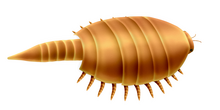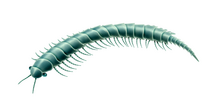
The Cambrian Period is the first geological period of the Paleozoic Era, and of the Phanerozoic Eon. The Cambrian lasted 53.4 million years from the end of the preceding Ediacaran Period 538.8 million years ago (mya) to the beginning of the Ordovician Period 485.4 mya. Its subdivisions, and its base, are somewhat in flux.
The PaleozoicEra is the first of three geological eras of the Phanerozoic Eon. Beginning 538.8 million years ago (Ma), it succeeds the Neoproterozoic and ends 251.9 Ma at the start of the Mesozoic Era. The Paleozoic is subdivided into six geologic periods :

The Silurian is a geologic period and system spanning 24.6 million years from the end of the Ordovician Period, at 443.8 million years ago (Mya), to the beginning of the Devonian Period, 419.2 Mya. The Silurian is the shortest period of the Paleozoic Era. As with other geologic periods, the rock beds that define the period's start and end are well identified, but the exact dates are uncertain by a few million years. The base of the Silurian is set at a series of major Ordovician–Silurian extinction events when up to 60% of marine genera were wiped out.
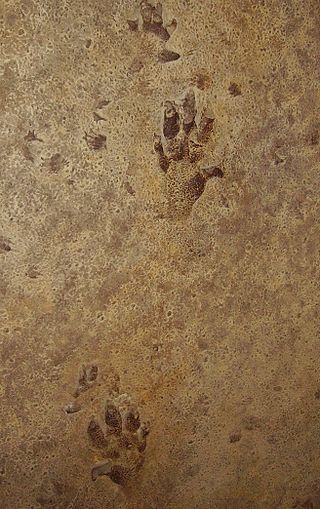
A trace fossil, also known as an ichnofossil, is a fossil record of biological activity by lifeforms but not the preserved remains of the organism itself. Trace fossils contrast with body fossils, which are the fossilized remains of parts of organisms' bodies, usually altered by later chemical activity or mineralization. The study of such trace fossils is ichnology and is the work of ichnologists.
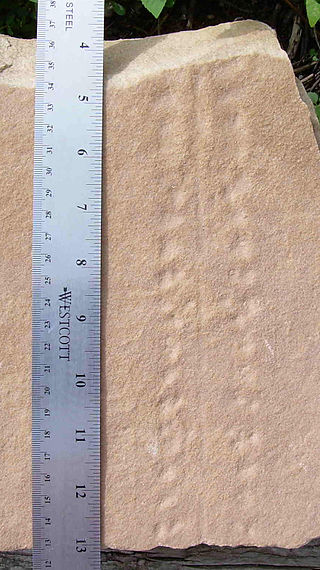
Protichnites is an ichnogenus of trace fossil consisting of the imprints made by the walking activity of certain arthropods. It consists of two rows of tracks and a medial furrow between the two rows. This furrow, which may be broken, set at an angle, and of varying width and depth, is thought to be the result of the tail region contacting the substrate.

Cheloniellida is a taxon of extinct Paleozoic arthropods. As of 2018, 7 monotypic genera of cheloniellids had been formally described, whose fossils are found in marine strata ranging from Ordovician to Devonian in age. Cheloniellida has a controversial phylogenetic position, with previous studies associated it as either a member or relative of various fossil and extant arthropod taxa. It was later accepted as a member of Vicissicaudata within Artiopoda.

Climactichnites is an enigmatic, Cambrian fossil formed on or within sandy tidal flats around 510 million years ago. It has been interpreted in many different ways in the past, but is now thought to be a trace fossil of a slug-like organism that moved by crawling to on-shore surfaces, or near-shore, or burrowing into the sediment.

Chasmataspidids, sometime referred to as chasmataspids, are a group of extinct chelicerate arthropods that form the order Chasmataspidida. Chasmataspidids are probably related to horseshoe crabs (Xiphosura) and/or sea scorpions (Eurypterida), with more recent studies suggest that they form a clade (Dekatriata) with Eurypterida and Arachnida. Chasmataspidids are known sporadically in the fossil record through to the mid-Devonian, with possible evidence suggesting that they were also present during the late Cambrian. Chasmataspidids are most easily recognised by having an opisthosoma divided into a wide forepart (preabdomen) and a narrow hind part (postabdomen) each comprising 4 and 9 segments respectively. There is some debate about whether they form a natural group.
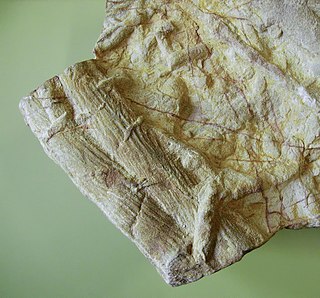
Cruziana is a trace fossil consisting of elongate, bilobed, approximately bilaterally symmetrical burrows, usually preserved along bedding planes, with a sculpture of repeated striations that are mostly oblique to the long dimension. It is found in marine and freshwater sediments. It first appears in upper Fortunian rocks of northern Iran and northern Norway. Cruziana has been extensively studied because it has uses in biostratigraphy, and because the traces can reveal many aspects of their makers' behavior.

Diplichnites are arthropod trackways with two parallel rows of blunt to elongate, closely spaced tracks oriented approximately perpendicularly to the mid-line of the trackway. The term is more often used for the ichnofossils of this description; however, similar trackways from recent arthropods are sometimes given this name as well.
The Tumblagooda Sandstone is a geological formation deposited during the Silurian or Ordovician periods, between four and five hundred million years ago, and is now exposed on the west coast of Australia in river and coastal gorges near the tourist town of Kalbarri, Kalbarri National Park and the Murchison River gorge, straddling the boundary of the Carnarvon and Perth basins. Visible trackways are interpreted by some to be the earliest evidence of fully terrestrial animals.

Legrandella is a genus of synziphosurine, a paraphyletic group of fossil chelicerate arthropods. Legrandella was regarded as part of the clade Prosomapoda. Fossils of the single and type species, L. lombardii, have been discovered in deposits of the Devonian period in Cochabamba, Bolivia.

Pseudoniscus is a genus of synziphosurine, a paraphyletic group of fossil chelicerate arthropods. Pseudoniscus was regarded as part of the clade Planaterga. Fossils of the genus have been discovered in deposits of the Silurian period in the United Kingdom, the United States and Estonia. Pseudoniscus is one of the two members of the family Pseudoniscidae, the other being Cyamocephalus.
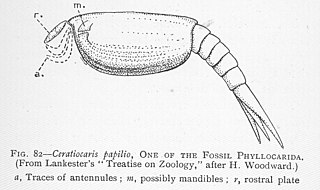
Ceratiocaris is a genus of paleozoic phyllocarid crustaceans whose fossils are found in marine strata from the Upper Ordovician until the genus' extinction during the Silurian. They are typified by eight short thoracic segments, seven longer abdominal somites and an elongated pretelson somite. Their carapace is slightly oval shaped; they have many ridges parallel to the ventral margin and possess a horn at the anterior end. They are well known from the Silurian Eramosa formation of Ontario, Canada.

The Potsdam Sandstone, more formally known as the Potsdam Group, is a geologic unit of mid-to-late Cambrian age found in Northern New York and northern Vermont and Quebec and Ontario. A well-cemented sandstone of nearly pure quartz, in the 19th century it was widely used in construction and in refractory linings for iron furnaces.
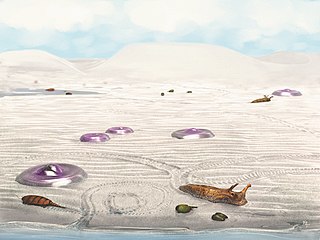
Blackberry Hill is a Konservat-Lagerstätte of Cambrian age located within the Elk Mound Group in Marathon County, Wisconsin. It is found in a series of quarries and outcrops that are notable for their large concentration of exceptionally preserved trace fossils in Cambrian tidal flats. One quarry in particular also has the distinction of preserving some of the first land animals. These are preserved as three-dimensional casts, which is unusual for Cambrian animals that are only lightly biomineralized. Additionally, Blackberry Hill is the first occurrence recognized to include Cambrian mass strandings of scyphozoans (jellyfish).

Paleontology in Wisconsin refers to paleontological research occurring within or conducted by people from the U.S. state of Wisconsin. The state has fossils from the Precambrian, much of the Paleozoic, some a parts of the Mesozoic and the later part of the Cenozoic. Most of the Paleozoic rocks are marine in origin. Because of the thick blanket of Pleistocene glacial sediment that covers the rock strata in most of the state, Wisconsin’s fossil record is relatively sparse. In spite of this, certain Wisconsin paleontological occurrences provide exceptional insights concerning the history and diversity of life on Earth.
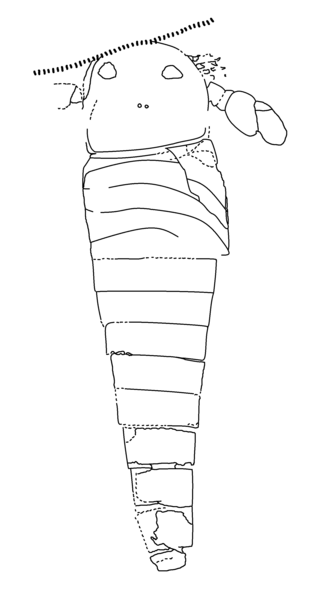
Dvulikiaspis is a genus of chasmataspidid, a group of extinct aquatic arthropods. Fossils of the single and type species, D. menneri, have been discovered in deposits of the Early Devonian period in the Krasnoyarsk Krai, Siberia, Russia. The name of the genus is composed by the Russian word двуликий (dvulikij), meaning "two-faced", and the Ancient Greek word ἀσπίς (aspis), meaning "shield". The species name honors the discoverer of the holotype of Dvulikiaspis, Vladimir Vasilyevich Menner.

Mosineia is a genus of euthycarcinoid arthropods that lived on tidal flats of Laurentia at what is now central Wisconsin from the Middle Cambrian to the Late Cambrian. It contains a single species, Mosineia macnaughtoni. Associated trace fossil evidence suggests that this genus spent some of its time subaerially, possibly to mate and to feed on the microbial mats that blanketed the beaches. The genus is named after Mosinee---the city in Marathon County, Wisconsin, near which the fossils were found. The collecting site is known as Blackberry Hill, which is a well known Konservat-Lagerstätte that produces abundant exceptionally preserved fossils.

Parioscorpio is an extinct genus of arthropod containing the species P. venator known from the Silurian-aged Waukesha Biota of the Brandon Bridge Formation near Waukesha, Wisconsin. This animal has gone through a confusing taxonomic history, being called an arachnid, crustacean, and an artiopodan arthropod at various points. This animal is one of the more famous fossil finds from Wisconsin, due to the media coverage it received based on its original description in 2020 as a basal scorpion.
